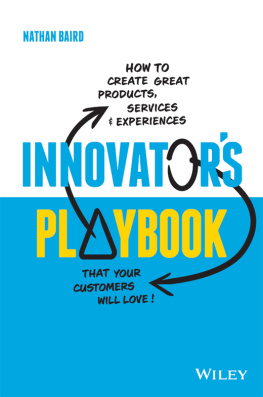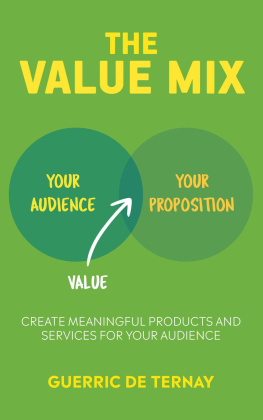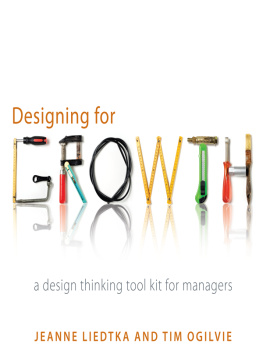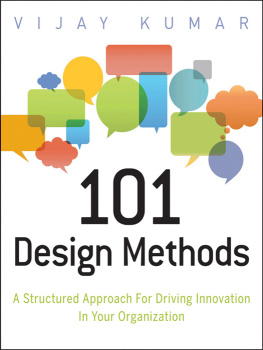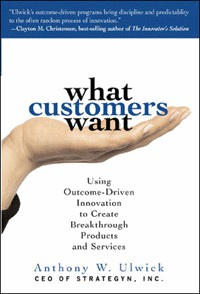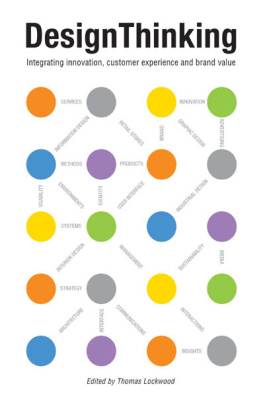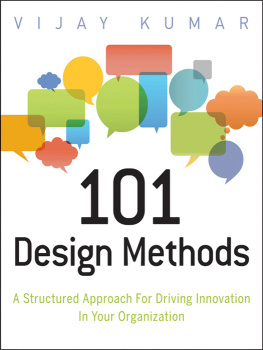
The role of design-led thinking has become essential to how we grow and thrive as organisations and nations. As one of Australias foremost Design Thinking, innovation and experimentation experts, Nathan shares his tips, tricks, methods and learnings for successfully mastering the innovation process. Innovators Playbook is a must-have for any organisation looking to put innovation first.
Rear Admiral Wendy Malcolm, Royal Australian Navy,
Head of Maritime Systems, Capability Acquisition
and Sustainment Group
Every business I come across wants to be more innovative. The challenge I hear time and time again is, we know we need to do this but we dont know where to start. Innovators Playbook is a brilliant book that links the process of creativity, design and innovation to business success in a practical, tangible and easy to digest manner. At a time when our world is facing ever-increasing complexity, this is a must read for every business leader.
Dr Brandon Gien, CEO Good Design Australia.
President Emeritus, World Design Organization.
most innovations fail because of little or poor work at the front end of innovation. I couldnt agree more, but in order to solve for this, you need your team to be trained for it. Nathan has a unique ability to put people at ease, explain pretty complex topics in digestible chunks and get everyone stuck in and trying out new skills.
Inga Latham, Chief Product Officer, Siteminder
One of the most practical books on innovation I have ever read. A fantastic tool for both the biggest and smallest of businesses.
Rob Weston, former Global Brand and Marketing
Director, Marks & Spencer
Its only appropriate that Nathan Baird has written the playbook on innovation. Nathan has helped dozens of companies of all sizes solve customer problems by creating new and innovative solutions which stand the test of time by being desirable, feasible and viable. Innovators Playbook is an essential guide for anyone wanting to succeed in an increasingly crowded market of new ideas.
Albert Naffah, General Manager Payments Development
& Strategy, Commonwealth Bank of Australia
First published in 2020 by John Wiley & Sons Australia, Ltd 42 McDougall St, Milton Qld 4064
Office also in Melbourne
John Wiley & Sons Australia, Ltd 2020
The moral rights of the author have been asserted
ISBN: 978-0-730-38364-2

All rights reserved. Except as permitted under the Australian Copyright Act 1968 (for example, a fair dealing for the purposes of study, research, criticism or review), no part of this book may be reproduced, stored in a retrieval system, communicated or transmitted in any form or by any means without prior written permission. All inquiries should be made to the publisher at the address above.
Cover, matter and stage opener design by Kyely Williams, Gamut Design
Some figures use images from: advent/Shutterstock, VLADGRIN/Getty Images, Mosquito-/iStockphoto, artsstock/Getty Images, Giraphics/Shutterstock, chris scredon/iStockphoto, alphaspirit/Getty Images, dizain/Shutterstock, multiple images by Pixaline from Pixabay, image by Pixel_perfect from Pixabay, image by Devanath from Pixabay, image by Clker-Free-Vector-Images from Pixabay, image by TukTukDesign from Pixabay, image by Pettycon from Pixabay, image by 200 Degrees from Pixabay, image by Megan Rexazin from Pixabay, image by gdakaska from Pixabay, image by OpenClipart-Vectors from Pixabay
Disclaimer
The material in this publication is of the nature of general comment only, and does not represent professional advice. It is not intended to provide specific guidance for particular circumstances and it should not be relied on as the basis for any decision to take action or not take action on any matter which it covers. Readers should obtain professional advice where appropriate, before making any such decision. To the maximum extent permitted by law, the author and publisher disclaim all responsibility and liability to any person, arising directly or indirectly from any person taking or not taking action based on the information in this publication.
My journey of discovery to innovation flow
Innovation is one of the riskiest,
yet most important,
endeavours of modern times.
Weve all heard about the need for innovation and its importance in organisations and economies. We know its value. In organisations innovation drives growth. For example, Procter & Gamble Chairman and CEO (and co-author of The Game Changer) A. G. Lafley used innovation to turn the P&G business around and create sustained and ever-improving organic revenue growth and profits, choosing innovation as the key driver because it is the best way to win in this world.
For humankind innovation drives development and helps us reach fulfilment. The human race has developed through creativity and innovation. In his best-selling book Flow, Professor Mihaly Csikszentmihalyi shares how, when we are involved in creativity and innovation, we feel that we are living more fully than during the rest of life.
Ultimately, organisations, the people within them, and the whole population, in fact, need the ability to innovate in order to develop, grow and reach any kind of fulfilment. Without it well all stagnate and possibly not even survive.
Yet innovation is hard and rarely successful. According to Harvard Business School professor Clayton Christensen 95 per cent of new products fail. And most start-ups fail, says start-up guru and author of the Lean Startup, Eric Ries. So, just like we need to continually innovate to grow and develop, we also need to continually grow and develop how we innovate.
What do we mean by innovation? I see innovation as the act of challenging the status quo to create new value that satisfies a human need.
If we break this down, then we are saying that innovation:
- is a verb; it is something you do
- challenges the status quo: think Cirque du Soleil, Apples iPod and iPhone, Nespresso, Uber, Airbnb
- must create new value; if it doesnt, then it is just creativity (or fun) without action and less likely to be successful
- must satisfy a human need; there is a human need at the end (or beginning) of every innovation. These humans can be customers, consumers, citizens, employees, end users and so on. For simplicity, throughout the remainder of this book I refer to all these types of humans as customers. The methods and lessons in this book are equally applicable to innovating for any one of these groups.
When we think of innovation we may think of new products, experiences, services or better ways of working (e.g. new systems and processes). The broad range of innovation is well illustrated by , global innovation firm Doblins Ten Types of Innovation.
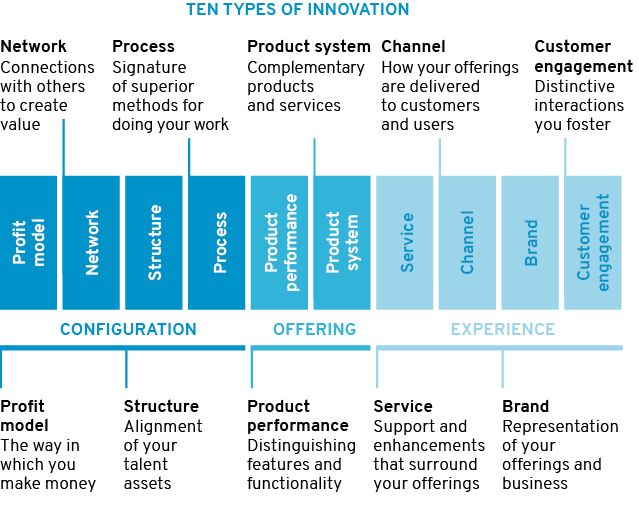
Doblins Ten Types of Innovation
Source: Larry Keeley, Ryan Pikkel, Brian Quinn and Helen Walters, Ten Types of Innovation: The Discipline of Building Breakthroughs (Hoboken, New Jersey: John Wiley & Sons, 2013)
My journey
After graduating with a Masters in Commerce my thesis was on branding I started out as a sales representative for FMCG (fast-moving consumer goods) giant Unilever. This was a great place for me to start my career, and all part of my plan of becoming a brand manager. In my final years studying Marketing at university many of the examples of great branding came from the FMCG industry; I was hooked and wanted to become a brand manager on an iconic FMCG brand think Coca-Cola, Gillette, Guinness, and so on. The advice given to me by those whod already made it was to start out at the coalface in sales before moving into brand management.
Next page
